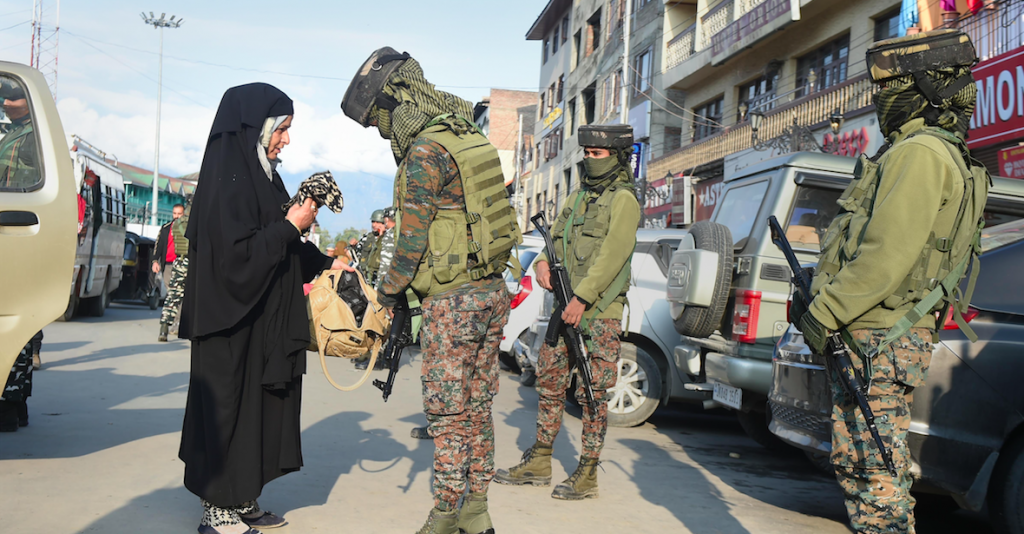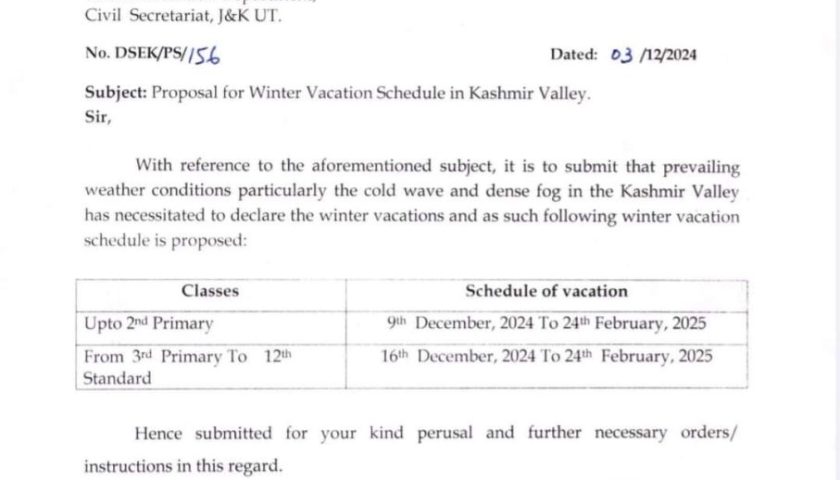None of the official domains, including channels that used to earlier announce them, record such outages. Nonetheless, they have crippled students and professionals.
By – Shakir Mir
Kashmir is not unaccustomed to extraordinary measures, of which it is on the receiving end when it comes to security.
In 2019 after the Pulwama suicide attack, authorities placed prohibitions on public movement along the National Highway in the Valley, withholding access to the crucial road for all except military vehicles, twice a week.
Since the period had coincided with the export of fruit, the ban dealt a severe blow to the region’s apple economy. It also affected pregnant women from all over South Kashmir whose access to the GB Pant Children’s Hospital, located on the highway upon entry into Srinagar city, was restricted. That year, the arrival of expectant mothers to the hospital declined up to 50% for the entire month during which the ban was in place.
Earlier this year, the government imposed a blanket ban on the sale, transportation, storage, and use of drones in Srinagar and Baramulla districts right after forces reported a string of militant attacks involving the use of drones, including the one at the Jammu airport. The ban has since left dozens of commercial drone operators in the lurch, throwing a wrench at their business.
Before that, a series of hit-and-run attacks in Srinagar city in February led to an unofficial ‘ban’ on the pheran, a loose Kashmiri winter garment made of tweed, with commuters being asked to take them off at police and CRPF checkpoints.
Recently, J&K police seized hundreds of bikes and scooters including those of riders who possessed all necessary documents. This adversely affected the online delivery business.
And who will forget the “longest Internet shutdown in a democracy”?
Now, the J&K administration appears to have changed tactics. Users in parts of Srinagar and Pulwama are complaining about spells of internet shutdowns. We got in touch with several users including academics, entrepreneurs, and journalists who said that the outages were unannounced, unofficial, and sudden.
Authorities had recently shut down the internet sporadically in several parts of Srinagar in the aftermath of a series of attacks targeting members of the minority community and migrant workers in the region.
One could access the internet, let’s say, near Hazratbal area in the city, but found that data connections suddenly snapped while turning the car towards Nowhatta, a neighborhood prone to stone-pelting. Then mobile data would suddenly spring into life as one approached the Fateh Kadal area.
But on October 19, these restrictions were reportedly lifted. Many users still complained that their internet access is shut for most of the day. Services, they say, resume mostly between 10 pm and 11 pm and continue through the night.
“We have been facing this situation since a gunfight took place in Pampore on October 16,” said Safina Nabi, an independent journalist from Pulwama town. “Internet works consistently only between 11 pm to 4 am. As for the day, services are erratic or sometimes we have none at all.”
Nabi shuttles between Srinagar and Pampore, where she resides, every day, just to make sure her work does not suffer on account of lack of internet connectivity.
“I am not associated with any publication. I pitch stories and need to research a lot. My work requires me to be in continuous correspondence with editors. Social media platforms enable me to find new contacts and interact with more people. How many times will I have to rush to Srinagar? It takes four hours to make a back-and-forth journey.”
Nabi says she struggles to strike a balance between commuting and working on her stories. “I will lose out if I don’t file my stories on time,” she said.
Other residents also complained of similar periodic shutdowns. “My daughter studies in an elementary school and she was supposed to sit for online exams at 10.30 am today. But the services were yet to resume and I had to later call her teachers who rescheduled the test for 11 am,” said the father from Pampore who requested anonymity because he is a government employee.
Residents of some parts of Srinagar have made social media posts to register their outrage at the internet shutdowns at “select” hours. “My eight-year-old nephew had a class/exam today at 4:30 but the mobile internet wasn’t working (it only works in the night and in the day from 11 – 4) and airtel fiber never works at home so he traveled 5 km with his mom and gave that class in a car,” tweeted @BandaySaab, a Srinagar based user.
We also spoke to several users in Srinagar neighborhoods like Safa Kadal who confirmed similar intermittent restrictions in their areas.
We tried to reach Vijay Kumar, IG Police of the Kashmir region via phone and text message but received no response. A search through the website of the General Administration Department which reports to the Lieutenant Governor also did not reveal any order authorising the latest restrictions. The Twitter handle of the Directorate of Public Relations, J&K whose timeline was once awash with internet ban orders before the restoration of 4G services in February 2021, also did not have any such order.
If indeed there is a legal order which backs the selective internet restrictions being reported by residents, they have not been put in the public domain in a manner in which the J&K government would previously do so.
AccessNow, a nonprofit, estimates that the Indian government mutes the internet more than any other country in the world. A majority of these outages take place in J&K. Of 548 internet shutdowns being recorded in India since 2012, 317 have taken place in J&K alone.
Software Freedom Law Centre says 41 shutdowns were imposed in India in 2021, of which 16, as per AccessNow, have occurred in J&K. The last internet outage reported by SFLC in J&K took place at Shopian on October 24. This coincides with the killing of a civilian Shahid Aijaz near the CRPF camp at Zainapora village in the district.
This means that the current internet restrictions are not even accounted for.
As per a report by the Jammu & Kashmir Coalition of Civil Societies (JKCCS), the legal mechanism underpinning the shutdowns in the Valley has historically remained shrouded in secrecy, with officials, while responding to litigations in the court, furnishing vaguely worded orders under Section 144 of Criminal Procedure Code.
That changed in the year 2017 with the enactment of Temporary Suspension of Telecom Services (Public Emergency or Public Safety) Rules 2017.
Since then, all such suspension orders were supposed to be made publicly available, a timeframe for suspension specified and a review committee set up.
Supreme Court and internet rights
In Anuradha Bhasin vs Union of India, which is lauded as among the most progressive judgments in recent times, the Supreme Court laid down strict guidelines for internet shutdowns.
The court held that blacking out internet services indefinitely was not permissible under the Temporary Suspension of Telecom Services (Public Emergency or Public Service) Rules, 2017 as the suspension can only be availed temporarily and that all such orders are subject to judicial review.
Though the judgment stopped short of calling access to the internet a fundamental right, it did, however, endorse the principle of proportionality for internet shutdowns while reading procedural safeguards into the Telecom Suspension Rules.
In the judgment, the court said that “competent authorities are directed to publish all orders in force and any future orders under Section 144, CrPC and for suspension of telecom services including the Internet to enable the affected persons to challenge it before the High Court or appropriate forum.”
It also held that “any order suspending the internet issued under the Suspension Rules, must adhere to the principle of proportionality and must not extend beyond necessary duration” and must be “subject to judicial review.”
It also outlined the remit of Section 144, calling it “remedial and preventive, exercisable…when there is an apprehension of [such] danger”…as deemed to be “in the nature of an “emergency” and for the purpose of preventing obstruction and annoyance or injury to any person lawfully employed.”
It held that the power under Section 144 “cannot be used to suppress the legitimate expression of opinion or grievance or exercise of any democratic rights” while also underscoring the need for application of mind.
Most importantly, the judgment held that “the Magistrate is duty-bound to balance the rights and restrictions based on the principles of proportionality and thereafter, apply the least intrusive measure.”
It’s worth mentioning here that during the court proceedings while hearing Bhasin’s petition, the judges had asked the J&K administration to produce the orders under which it sanctioned the suspensions, and then noted:
“The respondent (state) placed on record only sample orders, citing difficulty in producing the numerous orders which were being withdrawn and modified on a day to day basis.”
In the verdict, however, the court termed issuing repetitive orders, under Section 144, as an “abuse of power.”






